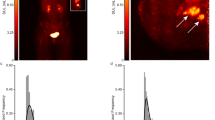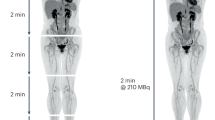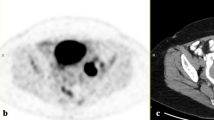Abstract
PET/CT imaging has rapidly emerged as an important imaging tool in oncology. The success of PET/CT imaging is based on several features. First, patients benefit from a comprehensive diagnostic anatomical and functional (molecular) whole-body survey in a single session. Second, PET/CT provides more-accurate diagnostic information than PET or CT alone. Third, PET/CT imaging allows radiation oncologists to use the functional information provided by PET scans for radiation treatment planning. In this Review we discuss the technical features of PET/CT, its economic aspects within the health-care system, and its role in diagnosis, staging, restaging and treatment monitoring as well as radiation planning in patients with cancer.
Key Points
-
PET/CT with the glucose analog [18F]fluorodeoxyglucose has emerged as an important tool for staging and restaging a variety of malignant tumors
-
PET/CT has been shown to be more accurate for detection of metastatic lesions than either PET or CT alone
-
By providing functional and morphological information in a single examination, PET/CT can shorten the diagnostic workup of cancer patients
-
PET/CT allows the functional information of PET to be used for radiation treatment planning purposes
-
PET/CT will facilitate the clinical use of new molecular imaging probes by showing the exact anatomical localization of their distribution in normal organs and in tumors
This is a preview of subscription content, access via your institution
Access options
Subscribe to this journal
Receive 12 print issues and online access
$209.00 per year
only $17.42 per issue
Buy this article
- Purchase on SpringerLink
- Instant access to full article PDF
Prices may be subject to local taxes which are calculated during checkout




Similar content being viewed by others
References
Phelps M et al. (1975) Application of annihilation coincidence detection to transaxial reconstruction tomography. J Nucl Med 16: 210–224
Reivich M et al. (1977) Measurement of local cerebral glucose metabolism in man with 18F-2-fluoro-2-deoxy-d-glucose. Acta Neurol Scand Suppl 64: 190–191
Schelbert H et al. (1979) Regional myocardial perfusion assessed with N-13 labeled ammonia and positron emission computerized axial tomography. Am J Cardiol 43: 209–218
Som P et al. (1980) A fluorinated glucose analog, 2-fluoro-2-deoxy-d-glucose (F-18): nontoxic tracer for rapid tumor detection. J Nucl Med 21: 670–675
Dahlbom M et al. (1992) Whole-body positron emission tomography: Part I. Methods and performance characteristics. J Nucl Med 33: 1191–1199
Beyer T et al. (2000) A combined PET/CT scanner for clinical oncology. J Nucl Med 41: 1369–1379
Townsend DW et al. (2004) PET/CT today and tomorrow. J Nucl Med 45: 4S–14
IMV (2006) 2005/06 PET Market Summary Report. IMV: Des Plaines. http://www.imvinfo.com/index.asp?sec=mkt&sub=omkt&pag=def&pid=42010
Halpern B et al. (2004) Impact of patient weight and emission scan duration on PET/CT image quality and lesion detectability. J Nucl Med 45: 797–801
Kim J-H et al. (2005) Comparison between 18F-FDG PET, in-line PET/CT, and software fusion for restaging of recurrent colorectal cancer. J Nucl Med 46: 587–595
Czernin J et al. (2007) Improvements in cancer staging with PET/CT: literature-based evidence as of September 2006. J Nucl Med 48 Suppl 1: 78S–88S
Zasadny K et al. (1996) Untreated lung cancer: quantification of systematic distortions of tumor size and shape on non-attenuation corrected 2-[fluorine-18]fluoro-2-deoxy-d-glucose PET scans. Radiology 200: 135–141
Kinahan P et al. (1998) Attenuation correction for a combined 3D PET/CT scanner. Med Phys 25: 2046–2053
Goerres G et al. (2002) PET-CT image co-registration in the thorax: influence of respiration. J Nucl Med 29: 351–360
Pan T et al. (2005) Attenuation correction of PET images with respiration-averaged CT images in PET/CT. J Nucl Med 46: 1481–1487
Nehmeh SA et al. (2004) Four-dimensional (4D) PET/CT imaging of the thorax. Med Phys 31: 3179–3186
Antoch G et al. (2002) Focal tracer uptake: a potential artifact in contrast-enhanced dual-modality PET/CT scans. J Nucl Med 43: 1339–1342
Antoch G et al. (2004) To enhance or not to enhance? 18F-FDG and CT contrast agents in dual-modality 18F-FDG PET/CT. J Nucl Med 45 (Suppl): S56–S65
Allen-Auerbach M et al. (2006) Standard PET/CT of the chest during shallow breathing is inadequate for comprehensive staging of lung cancer. J Nucl Med 47: 298–301
Schoder H et al. (2006) 18F-FDG PET/CT for detecting nodal metastases in patients with oral cancer staged N0 by clinical examination and CT/MRI. J Nucl Med 47: 755–762
Palmedo H et al. (2006) Integrated PET/CT in differentiated thyroid cancer: diagnostic accuracy and impact on patient management. J Nucl Med 47: 616–624
Yi CA et al. (2006) Tissue characterization of solitary pulmonary nodule: comparative study between helical dynamic CT and integrated PET/CT. J Nucl Med 47: 443–450
Kim SK et al. (2007) Accuracy of PET/CT in characterization of solitary pulmonary lesions. J Nucl Med 48: 214–220
Lardinois D et al. (2003) Staging of non-small-cell lung cancer with integrated positron-emission tomography and computed tomography. N Engl J Med 348: 2500–2507
Cerfolio R et al. (2006) Restaging patients with N2 (stage IIIa) non–small cell lung cancer after neoadjuvant chemoradiotherapy: a prospective study. J Thorac Cardiovasc Surg 131: 1229–1235
Tatsumi M et al. (2006) Initial experience with FDG-PET/CT in the evaluation of breast cancer. Eur J Nucl Med Mol Imaging 33: 254–262
Fueger B et al. (2005) Performance of 2-deoxy-2-[F-18]fluoro-d-glucose positron emission tomography and integrated PET/CT in restaged breast cancer patients. Mol Imaging Biol 7: 369–376
Bar-Shalom R et al. (2005) The additional value of PET/CT over PET in FDG imaging of oesophageal cancer. Eur J Nucl Med Mol Imaging 32: 918–924
Cohade C et al. (2003) Direct comparison of (18)F-FDG PET and PET/CT in patients with colorectal carcinoma. J Nucl Med 44: 1797–1803
Freudenberg LS et al. (2004) FDG-PET/CT in re-staging of patients with lymphoma. Eur J Nucl Med Mol Imaging 31: 325–329
Reinhardt MJ et al. (2006) Diagnostic performance of whole body dual modality 18F-FDG PET/CT imaging for N- and M-staging of malignant melanoma: experience with 250 consecutive patients. J Clin Oncol 24: 1178–1187
Cohade C et al. (2003) “USA-Fat”: prevalence is related to ambient outdoor temperature-evaluation with 18F-FDG PET/CT. J Nucl Med 44: 1267–1270
Allen-Auerbach M et al. (2004) Comparison between 2-deoxy-2-[18F]fluoro-[D]-glucose positron emission tomography and positron emission tomography/computed tomography hardware fusion for staging of patients with lymphoma. Mol Imaging Biol 6: 411–416
Dwamena B et al. (1999) Metastases from non-small cell lung cancer: mediastinal staging in the 1990s—meta-analytic comparison of PET and CT. Radiology 213: 530–536
Chen Y et al. (2006) Clinical usefulness of fused PET/CT compared with PET alone or CT alone in nasopharyngeal carcinoma patients. Anticancer Res 26: 1471–1477
Schoder H et al. (2004) Head and neck cancer: clinical usefulness and accuracy of PET/CT image fusion. Radiology 231: 65–72
Shim SS et al. (2005) Non-small cell lung cancer: prospective comparison of integrated FDG PET/CT and CT alone for preoperative staging. Radiology 236: 1011–1019
Votrubova J et al. (2006) The role of FDG-PET/CT in the detection of recurrent colorectal cancer. Eur J Nucl Med Mol Imaging 33: 779–784
la Fougère C et al. (2006) Value of PET/CT versus PET and CT performed as separate investigations in patients with Hodgkin's disease and non-Hodgkin's lymphoma. Eur J Nucl Med Mol Imaging 33: 1417–1425
Mottaghy FM et al. (2007) Direct comparison of [(18)F]FDG PET/CT with PET alone and with side-by-side PET and CT in patients with malignant melanoma. Eur J Nucl Med Mol Imaging 34: 1355–1364
Grosu AL et al. (2003) Validation of a method for automatic image fusion (BrainLAB System) of CT data and 11C-methionine-PET data for stereotactic radiotherapy using a LINAC: first clinical experience. Int J Radiat Oncol Biol Phys 56: 1450–1463
Ling CC et al. (2000) Towards multidimensional radiotherapy (MD-CRT): biological imaging and biological conformality. Int J Radiat Oncol Biol Phys 47: 551–560
Nestle U et al. (2006) Practical integration of [18F]-FDG-PET and PET-CT in the planning of radiotherapy for non-small cell lung cancer (NSCLC): the technical basis, ICRU-target volumes, problems, perspectives. Radiother Oncol 81: 209–225
Gregoire V et al. (2007) PET-based treatment planning in radiotherapy: a new standard? J Nucl Med 48 (Suppl 1): S68–S77
Caldwell CB et al. (2001) Observer variation in contouring gross tumor volume in patients with poorly defined non-small-cell lung tumors on CT: the impact of 18FDG-hybrid PET fusion. Int J Radiat Oncol Biol Phys 51: 923–931
Nestle U et al. (2005) Comparison of different methods for delineation of 18F-FDG PET-positive tissue for target volume definition in radiotherapy of patients with non-small cell lung cancer. J Nucl Med 46: 1342–1348
Chapman JD et al. (2003) Molecular (functional) imaging for radiotherapy applications: an RTOG symposium. Int J Radiat Oncol Biol Phys 55: 294–301
Daisne JF et al. (2004) Tumor volume in pharyngolaryngeal squamous cell carcinoma: comparison at CT, MR imaging, and FDG PET and validation with surgical specimen. Radiology 233: 93–100
Grosu AL et al. (2005) Positron emission tomography for radiation treatment planning. Strahlenther Onkol 181: 483–499
Grosu AL et al. (2005) L-(methyl-11C) methionine positron emission tomography for target delineation in resected high-grade gliomas before radiotherapy. Int J Radiat Oncol Biol Phys 63: 64–74
Grosu AL et al. (2005) Reirradiation of recurrent high-grade gliomas using amino acid PET (SPECT)/CT/MRI image fusion to determine gross tumor volume for stereotactic fractionated radiotherapy. Int J Radiat Oncol Biol Phys 63: 511–519
Grosu A et al. (2007) Hypoxia imaging with FAZA-PET and theoretical considerations with regard to dose painting using IMRT in patients with head and neck cancer. Int J Radiat Oncol Biol Phys 69: 541–551
Chao KS et al. (2001) A novel approach to overcome hypoxic tumor resistance: Cu-ATSM-guided intensity-modulated radiation therapy. Int J Radiat Oncol Biol Phys 49: 1171–1182
Weber WA (2006) Positron emission tomography as an imaging biomarker. J Clin Oncol 24: 3282–3292
Juweid ME and Cheson BD (2005) Role of positron emission tomography in lymphoma. J Clin Oncol 23: 4577–4580
Cheson BD et al. (2007) Revised response criteria for malignant lymphoma. J Clin Oncol 25: 579–586
Larson SM et al. (1999) Tumor treatment response based on visual and quantitative changes in global tumor glycolysis using PET-FDG imaging. The visual response score and the change in total lesion glycolysis. Clin Positron Imaging 2: 159–171
Beer AJ et al. (2006) Adenocarcinomas of esophagogastric junction: multi-detector row CT to evaluate early response to neoadjuvant chemotherapy. Radiology 239: 472–480
Wieder HA et al. (2005) Comparison of changes in tumor metabolic activity and tumor size during chemotherapy of adenocarcinomas of the esophagogastric junction. J Nucl Med 46: 2029–2034
Pöttgen C et al. (2006) Value of 18F-fluoro-2-deoxy-[D]-glucose-positron emission tomography/computed tomography in non-small-cell lung cancer for prediction of pathologic response and times to relapse after neoadjuvant chemoradiotherapy. Clin Cancer Res 12: 97–106
Goerres GW et al. (2005) The value of PET, CT and in-line PET/CT in patients with gastrointestinal stromal tumours: long-term outcome of treatment with imatinib mesylate. Eur J Nucl Med Mol Imaging 32: 153–162
Antoch G et al. (2004) Comparison of PET, CT, and dual-modality PET/CT imaging for monitoring of imatinib (STI571) therapy in patients with gastrointestinal stromal tumors. J Nucl Med 45: 357–365
Reske SN et al. (2006) Imaging prostate cancer with 11C-choline PET/CT. J Nucl Med 47: 1249–1254
Shields AF et al. (1998) Imaging proliferation in vivo with [F-18]FLT and positron emission tomography. Nat Med 4: 1334–1336
Buck A et al. (2003) Imaging proliferation in lung tumors with PET: 18F-FLT versus 18F-FDG. J Nucl Med 44: 1426–1431
Beer AJ et al. (2006) Positron emission tomography using [18F]Galacto-RGD identifies the level of integrin alpha(v)beta3 expression in man. Clin Cancer Res 12: 3942–3949
Larson SM et al. (2004) Tumor localization of 16β-18F-fluoro-5α-dihydrotestosterone versus 18F-FDG in patients with progressive, metastatic prostate cancer. J Nucl Med 45: 366–373
Linden HM et al. (2006) Quantitative fluoroestradiol positron emission tomography imaging predicts response to endocrine treatment in breast cancer. J Clin Oncol 24: 2793–2799
Gabriel M et al. (2007) 68Ga-DOTA-Tyr3-octreotide PET in neuroendocrine tumors: comparison with somatostatin receptor scintigraphy and CT. J Nucl Med 48: 508–518
Author information
Authors and Affiliations
Corresponding author
Ethics declarations
Competing interests
The authors declare no competing financial interests.
Rights and permissions
About this article
Cite this article
Weber, W., Grosu, A. & Czernin, J. Technology Insight: advances in molecular imaging and an appraisal of PET/CT scanning. Nat Rev Clin Oncol 5, 160–170 (2008). https://doi.org/10.1038/ncponc1041
Received:
Accepted:
Published:
Issue Date:
DOI: https://doi.org/10.1038/ncponc1041
This article is cited by
-
Improved identification of tumors in 18F-FDG-PET examination by normalizing the standard uptake in the liver based on blood test data
International Journal of Computer Assisted Radiology and Surgery (2024)
-
Optimal clinical protocols for total-body 18F-FDG PET/CT examination under different activity administration plans
EJNMMI Physics (2023)
-
Tumor volume-adapted SUVN as an alternative to SUVpeak for quantification of small lesions in PET/CT imaging: a proof-of-concept study
Japanese Journal of Radiology (2021)



